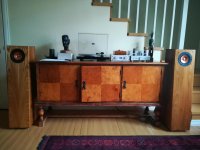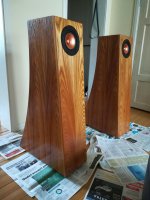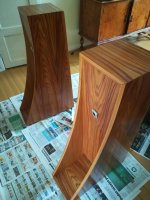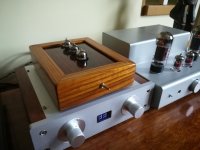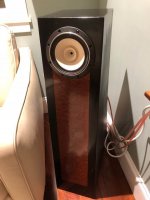Eric if formbys says so well giver.
I remember varnish cans telling us"do not us over shellac" i guess they should have said do not use over a thick layer of shellac with wax in it.
What they did not say was there is no better sealer coat under your varnish than shellac and it sands way better.
I so hate decptive marketing.
I dont get the point or benefit of using raw oil unless you plan on putting a traditional oil finish or oil &wax mix.
Most of my finishes are a blend of more basic ingredents (boiled oil, varnish, varsol a variety of shellacs and waxes).
Chris i have never uses that before they do have a variety of products, i will have to keep a eye out for them when in the bbox stores. My wife is always looking for better cleaners and polishes for the cupboards and floors.
I remember varnish cans telling us"do not us over shellac" i guess they should have said do not use over a thick layer of shellac with wax in it.
What they did not say was there is no better sealer coat under your varnish than shellac and it sands way better.
I so hate decptive marketing.
I dont get the point or benefit of using raw oil unless you plan on putting a traditional oil finish or oil &wax mix.
Most of my finishes are a blend of more basic ingredents (boiled oil, varnish, varsol a variety of shellacs and waxes).
Chris i have never uses that before they do have a variety of products, i will have to keep a eye out for them when in the bbox stores. My wife is always looking for better cleaners and polishes for the cupboards and floors.
I just realized I made a rather dumb mistake. The construction of my cabinets differs from the original plans in the way the front baffle is attached. In order to keep the inner dimensions the same I should have taken into account the different method of construction. I have this in my notes but, alas, it was never done. So, the inner chamber is too large by 18mm. Unfortunately at this stage I can't think of any easy (or even moderately difficult) way to fix it. How significantly can this affect the performance of the speakers?
So, the inner chamber is too large by 18mm. Unfortunately at this stage I can't think of any easy (or even moderately difficult) way to fix it.
Are these 18mm side to side or top to bottom?
Question regarding cabinetry:
If one doesn't want to pop screws or nails through the sides of the cabinets, would just glue hold the cabinet together with butt joints? Asking form a rigidity point of view, of course.
I'm planning to use already veneered plywood that's why I ask.
I assume I could dado the panels if needed, but really would prefer not to go through that trouble. If butt joints without fasteners is not recommended, would biscuit joint be a good compromise?
And question about acoustics:
Would it be damaging in any way to apply vinyl fabric (Pleather for example) to the front of the speaker cabinet . I've seen a commercial version of the FH with this kind of work and found it beautiful. However, I am concerned if in the DIY version that relatively padded material would be deleterious to performance in any way.
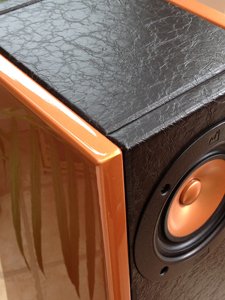
If one doesn't want to pop screws or nails through the sides of the cabinets, would just glue hold the cabinet together with butt joints? Asking form a rigidity point of view, of course.
I'm planning to use already veneered plywood that's why I ask.
I assume I could dado the panels if needed, but really would prefer not to go through that trouble. If butt joints without fasteners is not recommended, would biscuit joint be a good compromise?
And question about acoustics:
Would it be damaging in any way to apply vinyl fabric (Pleather for example) to the front of the speaker cabinet . I've seen a commercial version of the FH with this kind of work and found it beautiful. However, I am concerned if in the DIY version that relatively padded material would be deleterious to performance in any way.

Last edited:
If one doesn't want to pop screws or nails through the sides of the cabinets, would just glue hold the cabinet together with butt joints?
Yes, as long as you use good glue. I have even seen arguments that say screws degrade the strength.
dave
Are these 18mm side to side or top to bottom?
Thanks for the reply! Actually, never mind. I double checked and the dimensions are just what they should be, so the problem was in my head... Sorry, I must seem like a proper fool, but I do manage to confuse myself every now and then...
I removed a bunch of foam filling from the cabinets. If I recall I originally put 60g of foam to each speaker, and now I reduced it to 20g, expecting that I would have to put some back. It had a profound impact on the sound, in a very positive sense. The tin-canny effect I was describing earlier was eliminated to a large degree. What brightness is left is characteristic I'm sure. The soundstage opened up very nicely.
As to Paul's comment regarding using pure tung oil, at least in this case it makes a big difference in accentuating the grain. The effect is very pronounced compared to any other oil or wax I tried. Shellac I then use to provide a protective layer, and some shine.
I proceeded to apply the shellac now, and consider the speakers complete. I'll add a few photos to show the end result. There is a bonus photo of my phono stage, I made a new case for it from the scraps of this project.
Attachments
Thank you for the compliments, gents! I don't know about sweet spot yet, but there has been a definite improvement from the starting point. Pulling the speakers away from the wall helped too. Probably would be beneficial to do that even more, but then the speakers will already be in the way and the local government will start to issue protests. If you know what I mean. =)
The Local Government Who Must Be Obeyed... I’m sure the WAF is pretty good on those speakers though? They look great!
Thank you! My significant other was positively surprised about the end result, so yes, on the most important metric this project was a success.
This has been a lot of fun! I am already starting the next endeavour, which will be a turntable based on the core of an old Lenco.
I’ve been using my XL’s for a few years now and other speakers come and go st over 5 to 10 tines the price but these have remained!
Was wondering if a base makes any difference to the sound, mine just site on hard floor with nothing on the bottom. What’s the thought and experience on this please
Was wondering if a base makes any difference to the sound, mine just site on hard floor with nothing on the bottom. What’s the thought and experience on this please
Pass DIY Addict
Joined 2000
Paid Member
Nikodemuzz - what a beautiful set of speakers you've created! I've been busy with work lately and am just now finding your images. I LOVE that grain, the finish turned out great! My wife was rather pleased with my FHXLs, they are a bit shorter than my previous speakers and are quite a bit nicer than black rectangles.
Fostex FE163En-S
After stalling the build for years... it’s finally playing music.
I don’t have any other notable fullrangers to compare with and it is too soon to critique. These fostex haven’t played more than a few hours for a proper break in...
So far, they are enjoyable to listen to despite the lack of space for proper placement.
After stalling the build for years... it’s finally playing music.
I don’t have any other notable fullrangers to compare with and it is too soon to critique. These fostex haven’t played more than a few hours for a proper break in...
So far, they are enjoyable to listen to despite the lack of space for proper placement.
Attachments
There is somewhere here they talk about the breaking in of the ma10.3. Ive been using the ma10 p for about a year now . I have the 10.3 in boxes for about 6 months never used. Looks like I’m only sacrificing 1 dB or so on efficiency. So as all audiophiles that are impatient I’ve decided it’s time to try the metals. I’ve heard it take quite a bit longer for the ma10.3 to break in . Educate me!!! Thanks
Pass DIY Addict
Joined 2000
Paid Member
I don't have the link, but here are the details:
--------------------------------
Please run in the latest Markaudio drivers:
1 - First 100 hours - low volume music only. The music should be general/vocals with modest bass. Please don't use any artificial and/or single tone signal signals this risks creating a memory patten in the outer 7 to 10 micron cone substrate. You can run the drivers in free air or near free air, but pay attention to the physical movement, the driver's power-train should not move more than 1mm.
2 - From 100 hours to 300 hours, gradually increase the load to normal listening levels. Typically and depending on room size, the volumes should be around low 80's dB near constant loads with peak loads not exceeding 86dB. For those without any SPL measuring equipment, set your system to moderate listening levels. You should be able to hold a conversation without raising your voice while the drivers are being run.
3 - From 300 hours out, the driver's power-train will enter its optimal load phase on its suspensions. Markaudio driver suspensions are critical components as they have to cope with long-throw demands of the cone/coil. I recommend some care from 300 to 500 hours as fully optimised suspensions will give you many years of reliable service life. Bass loads are available but go a little easy on the volume until passed 500 hours.
Remember fellas, Markaudio drivers are "long throw" light load units. They will give you allot of wide usable band width but they aren't designed for near constant maxed volume "rock un roll". The latest models have built-in arrestors to help avoid damage from accidental over-load, so this helps but its not a replacement for commence sense operation of these types of drivers, be they Markaudio or other full-rangers.
Hope this helps.
Thanks
Mark.
--------------------------------
Please run in the latest Markaudio drivers:
1 - First 100 hours - low volume music only. The music should be general/vocals with modest bass. Please don't use any artificial and/or single tone signal signals this risks creating a memory patten in the outer 7 to 10 micron cone substrate. You can run the drivers in free air or near free air, but pay attention to the physical movement, the driver's power-train should not move more than 1mm.
2 - From 100 hours to 300 hours, gradually increase the load to normal listening levels. Typically and depending on room size, the volumes should be around low 80's dB near constant loads with peak loads not exceeding 86dB. For those without any SPL measuring equipment, set your system to moderate listening levels. You should be able to hold a conversation without raising your voice while the drivers are being run.
3 - From 300 hours out, the driver's power-train will enter its optimal load phase on its suspensions. Markaudio driver suspensions are critical components as they have to cope with long-throw demands of the cone/coil. I recommend some care from 300 to 500 hours as fully optimised suspensions will give you many years of reliable service life. Bass loads are available but go a little easy on the volume until passed 500 hours.
Remember fellas, Markaudio drivers are "long throw" light load units. They will give you allot of wide usable band width but they aren't designed for near constant maxed volume "rock un roll". The latest models have built-in arrestors to help avoid damage from accidental over-load, so this helps but its not a replacement for commence sense operation of these types of drivers, be they Markaudio or other full-rangers.
Hope this helps.
Thanks
Mark.
- Home
- Loudspeakers
- Full Range
- Frugel-Horn XL for Alpair 10.3/10p, Fostex FF165wk, more

